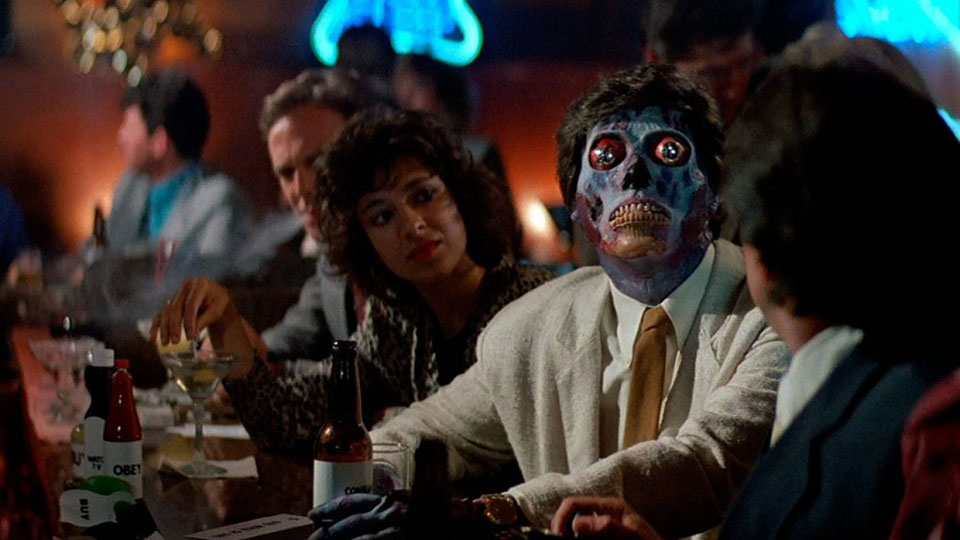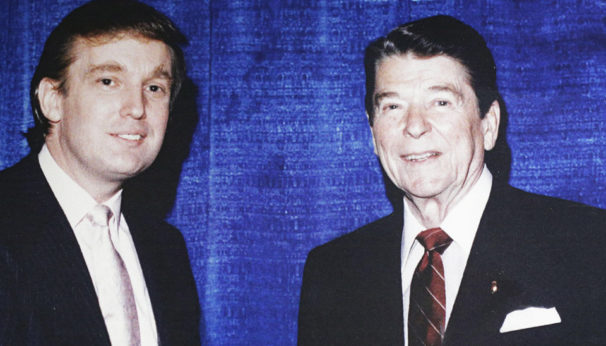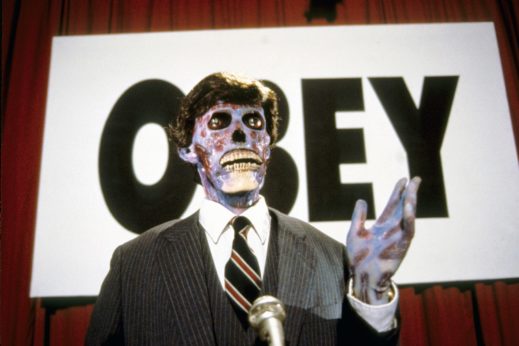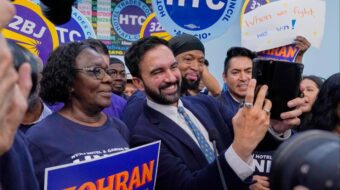
“DO NOT QUESTION AUTHORITY… OBEY.”
John Carpenter’s Halloween franchise has been celebrating box office success since mid-October, with the boogeyman Michael Myers scaring moviegoers once again four decades after his first appearance. Yet, it was thirty years ago this week that Carpenter debuted what would become a horror classic with a far more insidious “monster”—the capitalist class. They Live, which Carpenter wrote and directed, was released on November 4, 1988, and was a movie that used the horror genre to explore the nefarious nature of poverty, exploitation, consumer culture, and capitalism.
With the nation in complete political turmoil and the future of the country hanging in the balance in the midterm elections this week, it seems fitting to revisit and celebrate a film that is still just as relevant today as it was back on Election Day 1988 when all eyes were on Bush vs. Dukakis.
Based on the short story “Eight O’Clock in the Morning” by Ray Nelson, the film’s plot deals with an out-of-work blue-collar drifter who discovers that the ruling class are aliens who have concealed their appearance and are manipulating humans to accept the status quo with subliminal messages transmitted via the mass media. With the help of another fellow working man named Frank (Keith David) and an underground group of human rebels, the no-name drifter (called John Nada in the end credits), tries to thwart the extraterrestrials’ plan and expose their lies to the world. One would classify it as a science-fiction horror movie, but according to Carpenter, it wasn’t fiction at all.
To put the context of the film into perspective, They Live came out during the last days of Ronald Reagan’s presidency. The economic policy that Reagan advocated for, coined “Reaganomics,” was associated with supply-side theories and eliminating and restrictions on the free-market economy. Reaganomics pushed for lower taxes for the wealthy and less business regulation by the government. The idea was that showering the rich with even more money would result in a greater supply of services and goods, at lower prices, and an increase in employment. Basically, it was claimed that with more money in the pockets of the wealthy, and more unrestrained power given to corporations, the wealth would somehow trickle down into the pockets of the working class and the poor.

Many studies since have exposed trickle-down-theory, noting that often money does not trickle down from the pockets of the super rich, but rather continues to be amassed by them, as the wage gap and income inequality between classes grows. Of course, none of this has stopped Donald Trump from embracing Reagan’s theories as his own.
It also should be noted that Reagan gained quite the reputation as an anti-union president as well, thanks to a series of actions and policies he implemented that helped weaken the power of organized labor. An era where the so-called free-market economy was liberated and the rich were getting richer while the poor continued to suffer was—this was the context in which Carpenter created They Live. As he said in a 2015 interview with Yahoo news, “It’s a documentary. It’s not science fiction.”
The major highlights of the film are to found in its messaging and characters. Carpenter used John Nada (Roddy Piper) and Frank (Keith David), to symbolize the everyday working man. The two are down on their luck in Los Angeles, trying to find work due to the factories in their own cities closing up and skipping town. Frank and Nada live in a homeless tent area because they can’t afford to pay rent. Frank sends money back home to his wife and kids, whom he had to leave behind in order to find work.
The two characters have a few conversations in the film that touch on the real-life hardships working people face when businesses are allowed to just lay off workers with no accountability or liability. Frank and Nada are angry at the system they find themselves exploited in, and rightly so. Carpenter also makes sure that the faces of the poor reflect the diversity of who’s affected, as Frank is African-American, as are a number of the working poor in the film.
The messaging in the film is unmistakable. There is no confusion as to where Carpenter stood when it comes to the economic elite. Subliminal messages, such as “Marry and reproduce,” “consume,” “no imagination,” and “money is your God,” are all over billboards and magazines. There’s even a theme of some humans working against their own interests by siding with the aliens for monetary gain. There’s division in the underground rebellion over how to revolt against the aliens, and the question of strategy against a system meant to exploit is debated. It’s a super political film interwoven with action and horror.
The movie has some shortcomings, such as the lack of a major woman character on the side of the rebellion. It seems an oversight given that one of Reagan’s major campaign points was combating the fictitious and racist “welfare queen” associated by the media with Black women who supposedly committed welfare fraud. Not to mention that from the 1970s onward, women increasingly became the face of poverty. Today, the rate of impoverished women is still higher than that of men.

Yet, despite this oversight, and a ridiculously long fight scene in an alleyway, the messaging of They Live is just as relevant today as it was when it first hit theaters. We are now living in a time when, although we no longer call it Reaganomics, yet another White House administration pushes a policy of tax breaks for the super wealthy and prioritizes profits over people. Voter suppression runs rampant across the country with elections seemingly stolen. Yet such topics don’t earn nearly the amount of attention given by the mainstream media to the latest Trump Twitter rant.
These are turbulent times, and you don’t need alien-detecting sunglasses like John Nada had in the film in order to see it.
They Live is part of a legacy in the horror genre that deploys supernatural terror to reflect and comment upon real-life issues and social developments. As we go into the historic midterm elections of 2018, followed soon after, by the 2020 presidential election, a film like Carpenter’s reminds us that what we’re dealing with isn’t anything new, but part of a long history of exploitation and division. It’s a ‘monster’ that’s been with us for some time, but characters like Nada and Frank symbolize the human spirit of a working class not taking the exploitation lying down.
They Live is available to stream on Vudu, YouTube, iTunes, and Amazon Prime.










